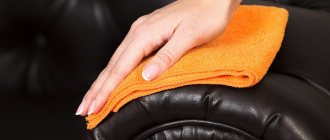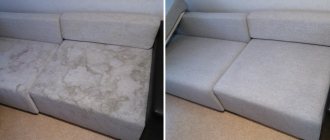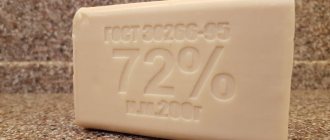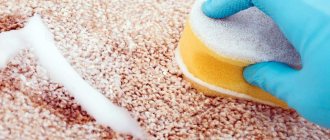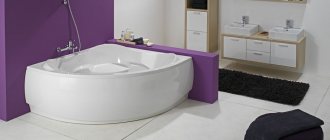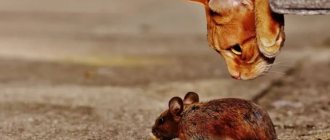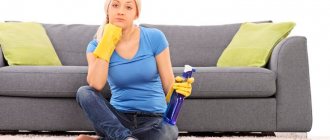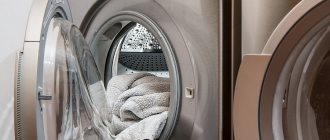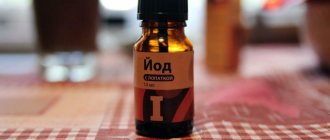| Place | Name | Characteristics in the rating |
| Top 10 best products for cleaning upholstered furniture |
| 1 | Pip “For removing stains” | The best organic stain remover |
| 2 | IVIclean "proTECt" | The most gentle care for fabric surfaces |
| 3 | BUGS SHTIKHONIT | The best disinfectant |
| 4 | VANISH | High efficiency |
| 5 | NORDLAND | Cleaning upholstery made from natural materials |
| 6 | UNICUM | The best combination of price and quality |
| 7 | Ekokemika Textile Interior | Does not leave streaks after use |
| 8 | GraSS Universal cleaner | Effective for all types of fabric |
| 9 | TUBA | Quick and dry cleaning |
| 10 | Pro-Brite Lenot | Economical professional textile cleaner |
Each house has at least one set of upholstered furniture. In rare cases, it serves well for many years and does not need cleaning. The presence of children, pets, as well as the habit of household members to eat while sitting in an easy chair inevitably adds stains to the upholstery. Simple daily cleaning activities cannot get rid of such contaminants. A deeper cleaning using special products is required.
Some people use removable covers for upholstered furniture, washing them periodically in an automatic machine. But this does not help with all stains. Dust, abundant liquid pollution, and animal traces can only be thoroughly treated with chemicals. The best option for cleaning surfaces at home is cleaning with special liquids. When choosing, they are guided by the quality of the material, the intensity of contamination, and safety. Before you start cleaning, you should conduct a test on a small area to make sure that the method is suitable for the item. The most effective of them are presented below in our rating of upholstery cleaning products.
Folk remedies for cleaning furniture upholstery
So, now let’s look at effective means for cleaning upholstery, which cost a very small amount of money, since in order to save money they were invented by people themselves. At the same time, their effectiveness is practically not inferior to industrially produced household products. Let's look at the most effective recipes.
The effectiveness of folk remedies sometimes even exceeds that of household chemicals
Recipe No. 1 - a powerful cleaning product with a simple composition
So, to clean furniture upholstery for fabric, you can prepare a special composition, which will include
- a teaspoon of Feri or other dishwashing liquid;
- a spoonful of vinegar essence;
- a cup of heated water;
- a teaspoon of ordinary soda.
Mix all the ingredients in a larger container so that the foam has room to release.
That's all. You will need to work with this composition using a clean sponge (to apply the product), as well as an absorbent cotton towel (to remove any remaining product).
Please note: you need to mix all of the listed products in a basin, and immediately shortly before using the homemade composition, since when soda and vinegar essence come into contact, a powerful release of carbon dioxide will occur, and the accompanying formation of foam, which is what we need to use for work with stains on the upholstery.
We need to use this rich cleansing foam to remove dirt.
Recipe No. 2 – salt water
A very effective way to remove tea and coffee stains is salt water. It's simple to prepare: take a bowl of water and generously salt it until the solution becomes very salty indeed. You will need to treat the sofa in the area of contamination with this liquid, and after the wetted area has dried, vacuum the upholstery.
Salt water is a good upholstery cleaner, and most importantly, it’s natural.
Please note: salt, by itself, also works extremely effectively as a stain remover, however, it only shows a clear result on fresh stains. So, for example, if you spill wine on the upholstery, you can immediately pour a thick layer of salt on it, and it will absorb all the liquid, leaving only minor traces on the sofa that you can remove by other means.
In its pure form, salt works well to remove red wine from fabric surfaces.
Recipe No. 3 - alcohol solution
Another effective remedy is an alcohol solution. It can be prepared by mixing:
- 5 tablespoons of pure alcohol;
- 200 milliliters of water.
You will need to moisten a sponge in this liquid and treat the stains with it.
Alcohol or vodka with water perfectly cleans stains that are ingrained into the upholstery.
Please note: since alcohol has not been sold in its pure form for a long time, if you, of course, do not have any reserves left, replace the required element in the recipe with vodka. However, you need to take into account that vodka is also an already diluted liquid, so the proportions will change somewhat, that is, you will need to take more vodka and less water.
How to train yourself to clean your apartment regularly
Constant light or periodic general cleaning of the apartment will rid the home of dust and harmful substances, so it will be easy to breathe. True, there is not always time and desire for this. Inviting guests can be an ideal motivation. It is unlikely that the hostess will want her guests to witness chaos and disorder.
Clean in the morning when you are full of strength and energy. In the evening after work, you don’t want to do the cleaning, because at this time there is a certain loss of energy, and the negative emotions accumulated during the day do not allow you to do something useful.
You can choose a specific day a week and clean regularly. Even if there is no desire, you still don’t need to relax. After a few months, you will become so involved in this process that you simply cannot live without cleaning. You will be missing something on this day.
While cleaning, do not be distracted by other things, since the intended work must be completed. All this will become a habit over time. If you always want to return home in high spirits, periodically change the decor in your home: carry out cosmetic repairs, change the wallpaper, rearrange the furniture.
Places where dirt accumulates the most
Despite regular wet cleaning, some rooms have significantly more dust than other rooms. This is due to the fact that the smallest particles, invisible to the eye, remain in the air for quite a long time and do not settle on the surface of things immediately. These particles include small fabric fibers, fragments of ceiling and wall trim, as well as pet hair and microorganisms.
There are many hard-to-reach places in rooms where dirt accumulates - a kitchen hood, TV, refrigerator and other household appliances. Much of the dust can be found among scattered things.
Attention! Small particles of dust, being in the air for a long time, attract harmful substances that can be hazardous to health. They cause the greatest harm to people susceptible to allergies.
Dust also accumulates on the sides of paintings, lamps, clocks and in various small objects that are not even paid attention to during cleaning. This is due to some difficulties in cleaning them. By the way, to make work easier, small items can be treated with a spray.
Microscopic particles settle in large quantities on interior items made from textiles. The electrified material has the properties of attracting small dust particles. No less dust accumulates under the ceiling, which is often forgotten.
Caring for rattan furniture
Rattan wood is naturally resistant to moisture, and finished furniture is coated with varnish or wax. This means that dust is removed with a sponge and soap solution. You don't need to buy any special shampoos. Take one that is suitable for parquet, laminate or carpet. A difficult stain can even be rubbed a little.
Natural rattan is hardy and not afraid of moisture
For wicker furniture without inserts, short-term wetness is not dangerous. Therefore, rattan garden furniture can be washed with a stream of water, but immediately dried in the open air. There is no need to do such general cleaning often, maximum once a year.
Houseplants against dust
There are certain types of indoor plants that can attract dust, and the housewife can only wipe the leaves with a damp cloth.
Helps remove dust:
- Ficus benjamina. Absorbs toxic compounds released by some plastic and other products.
- Chlorophytum. Absorbs any toxic substances in the room.
- Geranium. Destroys germs and bacteria.
- Spathiphyllum. Suppresses the development of mold.
- "Mother-in-law's tongue." Successfully resists nitrogen oxides.
- Cypress. Effectively attracts negative ions coming from electrical appliances.
- Gerbera. They actively absorb carbon dioxide and release oxygen.
- Begonia. Destroys microorganisms and humidifies the air.
- Dieffenbachia. Destroys staphylococcus and toxic compounds.
- Scheffler. Absorbs nicotine. This plant is useful in an apartment whose owner prefers to smoke while sitting in a chair instead of going out onto the balcony.
Special devices
All equipment required for cleaning furniture is divided into two types: household and professional. The first one can be found in every home and is quite suitable for cleaning a sofa at home.
Household tools:
- brush;
- rags;
- bucket;
- vacuum cleaner.
Vacuum cleaner
Brush
This category may also include different types of washing vacuum cleaners and steam generators, if they were produced for domestic use.
Professional devices are quite expensive; few people would decide to buy one for the sake of one sofa. Such tools are intended for constant work. With intensive use, it quickly pays for itself, but in everyday life it will simply gather dust in the closet.
- Professional washing vacuum cleaners. They differ from household ones mainly in size, power and complete disregard for design.
- Furniture dryers. Essentially, these are just specialized hair dryers.
- Minirotors. Electric brushes make it easier to clean hard-to-reach places.
- Foam extractors. Modernized washing vacuum cleaners that use thick foam instead of water.
All machines are very powerful, you won’t be able to get gentle cleaning from them. But the one-time effect will be amazing; stubborn stains will disappear completely. True, along with the dirt, the upholstery of the sofa will become thinner, and the soft filling will become a little harder.
Minirotor
Foam extractor
Professional washing vacuum cleaner
Caring for furniture made of MDF and chipboard
MDF and chipboard are types of particle boards. In furniture production, composite materials are refined by gluing PVC (polyvinyl chloride) film onto them.
MDF and chipboard boards can be decorated with films of different textures and colors
IMPORTANT . The weak point of furniture made of MDF and chipboard is the edge at the ends of the products: moisture can easily get under it. Another danger for film facades is steam and high temperature.
Otherwise the film does not cause problems. It can be washed with soap and even wiped with glass cleaner. There is no point in applying polishes and waxes; special care is not required.
MDF boards are also painted in production (chipboards are not). Wash painted surfaces with water and a drop of dishwashing detergent, and then wipe dry. You don't need to do anything else.
Professional dry cleaning
Professional dry cleaning at home is a reality, not a dream. We will not reveal the secrets of professionals, but we can say that their work looks very impressive. Before our eyes, literally in a matter of seconds, the canvas, which was just gray and dirty, becomes clean and brightened by several tones. This is where the real miracle hides!
Of course, professional dry cleaning is the most effective method of removing dirt, but it is very expensive and is not always necessary.
The most effective solution is professional dry cleaning
Types of sofa cleaning products
Household chemicals
First, let's look at the category that is the most popular. We are talking about widely used products – household chemicals, the advantages of which include:
- affordable price;
- sufficient efficiency;
- quick results.
You can find a wide variety of cleaning products on store shelves.
Of course, there are a huge number of products in the world that are actually capable of cleaning a sofa from dirt as quickly and efficiently as possible, however, we will present you with a selection of only those that occupy the first positions in the rating compiled by our compatriots. So let's get started.
"The bugs are quiet"
This upholstery cleaner comes in spray form. In many online ratings compiled from reviews of network users submitted by ordinary people, this tool ranks almost first among all available options.
The features of this spray include:
- effective removal of stubborn stains;
- complete removal of traces of biological fluid of people and animals (blood, urine, feces, pus, etc.);
- Possibility of use on the entire surface of the upholstery at the same time;
- restoration of fabric color;
- complete removal of unpleasant odors;
- destruction of bacterial microflora and other harmful microorganisms.
A very effective, but very expensive Israeli product for cleaning sofa upholstery
Another advantage of this spray is its neutral effect on the non-fabric elements of some sofas, that is:
- paintwork;
- rubber;
- wood;
- plastic, etc.
One cannot help but be pleased with one more positive performance characteristic of the product: it does not emit any pungent odors, and the subtle aroma emanating from it is even pleasant.
However, this Israeli product also has disadvantages. As you know, the more effectively a product works, the more likely it is to:
- more dangerous;
- expensive.
You can buy this product in almost any store.
This statement is relevant for the spray in question, therefore, when buying it, prepare to empty your wallet, as well as to work in a full set of protective equipment.
"Vanish"
This stain remover is known to every housewife and every owner of their home, as it works really effectively, and has been one of the leaders in the domestic market for decades.
The required product equally effectively removes old stains from sofa upholstery:
- coffee;
- blood;
- ink, etc.
Vanish
Thanks to its special formula, due to oxygen saturation, contaminated surfaces are really quickly cleaned of stubborn pigment.
The advantages of this product also include the fact that it does not contain chlorine or other potent substances, and therefore it is practically harmless to humans.
Please note: this stain remover is not intended for cleaning delicate textiles such as:
- wool;
- silk;
- brocade;
- velvet.
But it copes with ordinary sofa upholstery with a bang.
The oxygen form “Vanish” allows you to quickly and effectively remove dirt from upholstered furniture
How to clean a sofa with Vanish
So, let's look at how to properly use Vanish to clean a dirty sofa.
Step No. 1 – preparatory process
Before you start applying the product, you need to prepare the surface of the sofa for washing by vacuuming it thoroughly. The fact is that the dust that settles in the upholstery will form streaks when wet and will eat into the fabric even more strongly, therefore, it is better, of course, to remove it immediately.
Here you can use, for example:
- vacuum cleaner;
- a wet sheet placed on the sofa and a beater;
- other methods of dust removal known to you.
Having completed the preliminary cleaning, we proceed to the next stage.
First you need to prepare to apply the product and vacuum the sofa
Step No. 2 – use the product
Apply the product to the upholstery. Depending on the form in which you purchased it (spray, shampoo, foam), the application method will vary. Check the instructions and do everything as written inside it. Rub the application area with a sponge or a special upholstery brush.
After application, look at the instructions again. From it you will find out how long you will need to wait for the stains that have become embedded in the upholstery to come off.
Apply Vanish to the sofa and rub the stubborn stain
Step No. 3 - wash off the product
At the end of a certain period of time, wash the product off the surface of the sofa with a damp cloth, or remove any remaining residue in another way, also indicated in the instructions included with the product. Check if the cleaning has the expected effect. If the answer is positive, then remove the product, and if negative, then try re-cleaning.
When finished, remove the product with a special cloth.
"Tuba"
Tuba cleaning foam, made in Germany, not only costs quite reasonably (around 300 rubles), but also works very effectively. It was specially designed for quick and dry cleaning of upholstered furniture, as its manufacturer claims.
The main advantage of “Tube” is, of course, that it protects the surface of the sofa from getting wet, which entails the flow of dirt into its deeper layers.
This foam for cleaning sofa surfaces works effectively and is inexpensive
Tube foam is suitable for both synthetic and natural materials. By the way, with the help of this product you can safely remove hair left by a shedding dog or cat from the sofa.
Caring for metal furniture
For daily cleaning of metal furniture, use a simple soft cloth. Once every couple of months, wipe with a cloth soaked in cleaning paste or cream (look for the name of the appropriate metal on the packaging). Everything is ready: there is no dirt, shine appears and oxidative processes stop.
Metal furniture can be treated with an antistatic agent, then there will be less dust
Those who decide to install it in a bathroom or other damp room should check furniture for corrosion. If you notice a problem, treat it immediately, without delaying it for later.
Caring for veneer furniture
Veneer is the thinnest (from 1 mm) cut of valuable wood. Natural veneer is glued to MDF or cheaper wood, for example, pine. When making furniture, veneered parts are coated with protective impregnations or varnish.
Natural veneer looks almost no different from solid wood
The first enemy of veneer is water. After removing the dust with a damp cloth, immediately wipe the furniture dry. If moisture gets under the veneer sheet, it may peel off. Contact with hot or too cold dishes will result in unsightly stains.
ADVICE. Basic care for furniture made from natural veneer is the same as for wood furniture. Care for artificial (synthetic) veneer as you would for MDF furniture covered with PVC film.
Methods for reducing dust on surfaces
You can reduce the amount of accumulated dust by getting rid of things that can attract small particles. To permanently remove dust, you first need to get rid of the things that attract it. Instead of curtains, you can install blinds, and instead of carpet, install parquet. It will not spoil the aesthetics of the room, but rather will make the room more attractive. The chandelier should be ordinary, without pendants, and books should be kept behind glass.
In addition, woolen items and soft toys also accumulate dust in large quantities. All this can be simply vacuumed; the equipment quickly and completely removes dust from things. The knocking out method will not give such a result. You can hit the carpet with a beater all day, but there will still be dust in it.
Blankets, mattresses and pillows should be ventilated and preferably kept in direct sunlight. Some microorganisms are killed by ultraviolet radiation. Synthetic pillows are washed, and down pillows are sent for cleaning. It is better to use the mattress together with a cover, like a pillow with a pillowcase. In this case, only the cover needs to be washed.
All sorts of unwanted elements accumulate in sheets and duvet covers:
- dust;
- dead skin particles;
- various fabric fibers;
- sand;
- microbes
Attention! For safety and hygiene reasons, bedding should be washed and boiled at least once every five days. It is recommended to wash children's bedding every three days. Pillows and blankets filled with natural down are cleaned every 3 months.
Regardless of the circumstances and negative emotions accumulated during the day, it is necessary to maintain a comfortable microclimate in every living room. This can be done by ventilating the premises, as well as using a humidifier. The main thing to know is that the rooms should not be too hot, since heat provokes the appearance of harmful microorganisms, creating favorable living conditions for them.
Where to start cleaning
First of all, cleaning the premises begins with the removal of objects and things that have the properties of attracting dust. Most of it is concentrated in the lower part of the room, so children suffer more from dust, although they do not notice it.
Children generally get more damage than adults, since quite a lot of dust accumulates in soft toys. Since you can’t throw them away, you need to store them in boxes. The same applies to books. Being in an open space, printed publications also attract dust, so books should be kept behind glass.
Especially incredibly large amounts of dust accumulate in carpets that cover floors and wall hangings. They need to be vacuumed much more often than wiping furniture. Things that have not been used for years can be put in plastic bags and hidden in the pantry, or better yet, given to people in need.
Ways to eliminate dust
Small particles will not cover the surfaces of solid objects longer if they are treated with factory detergents. They remove static electricity, which prevents dust from being attracted. You can use your own preparations.
Lemon solution works well. It reliably removes minor dirt, after which no streaks or drips remain. To prepare this composition, pour small lemon slices with vegetable oil and wait 5 days. Boiling water is added to the resulting preparation, filtered and the fabric is soaked in it. Then it is dried and all surfaces are wiped with it.
Lavender oil is an excellent antistatic agent. It is stirred in water, and then using a cloth soaked in the solution, the furniture is wiped. A good solution is a mixture of bleach dissolved in water. Another option for a natural antistatic agent is a composition made from water and regular salt. Polished surfaces can be wiped with glycerin diluted with water.
Important! You can add water and shampoo to any antistatic agent, mix thoroughly and treat any surface. This will protect the products from dust accumulation for a long time.
The main thing is not to forget about special soft napkins and fleecy or woolen fabric. The use of other auxiliary means is not recommended. Dust accumulates in the pile, which prevents even microparticles from rising up, and the wool becomes electrified, so it attracts not only small dust particles, but also large ones.
Why is more than 90% of advice from the Internet evil?
In most cases, events develop according to the standard pattern:
→ something was spilled on the sofa or contamination was accidentally discovered,
→ Googled “how to remove coffee, wine or juice stains”
→ opened the first article with tips in search engine results,
→ did everything according to the instructions,
→ received a zero or negative result
